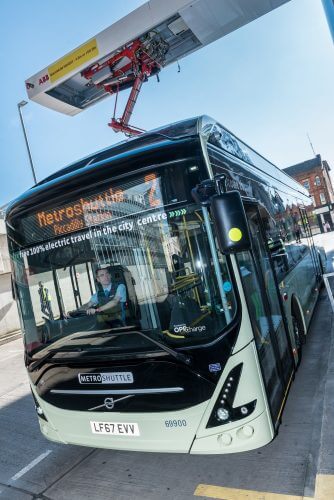
Martin Hale, ABB EV Infrastructure – UK and Ireland, talks to Jade Smith about the technology behind opportunity charging and ABB’s recent support to Volvo’s UK electric bus tour
ABB provides electrification products, robotics and motion, industrial automation and power grids, serving customers in utilities, industry and transport & infrastructure globally. ABB has supplied the first opportunity charging station for buses in the UK on Volvo’s UK electric bus tour, which utilises Volvo’s first right hand drive 7900e fully electric single deck bus.
The pilot was launched in Manchester on September 22, and will be in the city for eight weeks. Operated by First Manchester for Transport for Greater Manchester, the single deck vehicle is operating on the Metroshuttle 2 route – a free-to-use service that provides access to key locations across the city.
The zero-emission, fully electric bus will be recharged on the route, taking between three to six minutes via the OppCharge pantograph from ABB. Installed at Shudehill Interchange, this is the first time the system has been used in the UK, giving flexibility and the possibility of 24-hour continuous operation.
Martin Hale at ABB is responsible for EV charging infrastructure at ABB for the UK and Ireland. He went into detail on what his side of the business has recently been doing.
ABB
Martin began by outlining what ABB does: “ABB is a supplier in DC fast charging, with a global installed base of more than 6,000 chargers since 2010. To date, ABB has installed 15 OppCharge systems across the world, enabling more than 150 electric buses to be charged. Our OpCharge stations are based Canada, Sweden, Belgium, Luxemburg, the Netherlands and the UK.
“OppCharge is an open interface for the automated charging of both single and double-deck electric buses, from any manufacturer, using a pantograph on the infrastructure to connect the bus to the charging point.”[…]
By subscribing you will benefit from:
- Operator & Supplier Profiles
- Face-to-Face Interviews
- Lastest News
- Test Drives and Reviews
- Legal Updates
- Route Focus
- Industry Insider Opinions
- Passenger Perspective
- Vehicle Launches
- and much more!


